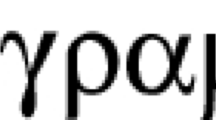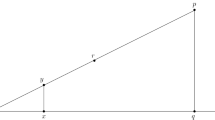Abstract
The term ‘absolute geometry’ was coined by János Bolyai to characterize the part of Euclidean geometry that does not depend on the parallel postulate. In the framework of Cayley–Klein geometries the parallel axiom characterizes three classical geometries, namely Euclidean, Galilean and Minkowskian planes. We study the part of Galilean geometry that does not depend on the parallel postulate (briefly called absolute isotropic geometry) and their models (isotropic planes). After an axiomatic foundation of absolute isotropic geometry, we develop the basic theory of isotropic planes, prove the theorem of Saccheri for the angle sum of a triangle, and construct models of the different types of planes (over fields and skew fields of characteristic \(\ne 2\)). Surprisingly, these models have counterparts in the theory of Hilbert planes. The article closes with a comparison between Hilbert planes and isotropic planes.
Similar content being viewed by others
Notes
We consider in this article only plane geometries.
This consensus has been reached by the end of the first half of the 20th century, based on the work of Skolem, Hilbert and Ackermann, Gödel, and Tarski.
That is, a sentence \(\varphi \) is a theorem of \(\mathcal {T}\) if and only if the translation of \(\varphi \) is a theorem of \(\mathcal {T'}\), and vice versa.
This holds under mild hypotheses with respect to the axioms of \(\mathcal {T}\), which all axiom systems of this article satisfy (see [32]).
The (Witt) index of a quadratic space (V, f) is defined to be the maximal dimension of a totally isotropic subspace of V/RadV (see [3, p. 311]).
A group is linearly orderable if and only if there exists a partition into cones; see [28, Theorem 3.3].
The continuity axiom implies the Archimedean axiom which Hilbert used in [13]. Neither of these axioms can be stated in first-order logic.
In the literature division rings are also called ‘distributive Veblen–Wedderburn systems’ (see Hughes and Piper [17]).
\(\angle (a, a, a^{+}, a^{-})\) is a zero angle (whose interior \( a^{+} \cap a^{-}\) is void). Any two zero angles are congruent.
The neighborhood is defined with respect to the order topology.
In [10] the field K and the metric constant k are denoted by M respectively \(\kappa \).
The axiom was introduced in R. Struve [30] for a characterization of the part of Euclidean geometry which satisfies the principle of duality.
In other words, if A is a point, which is not incident with a line b then \(n = 0\) or \(n = 1\) or \(n = 2\) according as there are 0, 1 or at least 2 lines through A which are ‘parallel’ to b (i.e., which have no common point with b).
A non-Legendrean Hilbert plane is locally elliptic, since it is a locally complete subplane of the associated elliptic ideal plane (see Bachmann [3, § 18,3]).
References
Bachmann, F.: Zur Parallelenfrage. Abh. Math. Sem. Univ. Hamburg 27, 173–192 (1964)
Bachmann, F.: Modelle der ebenen absoluten Geometrie. J.-Ber. dtsch. Math.-Verein. 66, 152–170 (1964)
Bachmann, F.: Aufbau der Geometrie aus dem Spiegelungsbegriff, 2nd edn. Springer, Heidelberg (1973)
Bachmann, F.: Ebene Spiegelungsgeometrie. Eine Vorlesung über Hjelmslev-Gruppen. BI-Wissenschaftsverlag, Mannheim (1989)
Behnke, H., Bachmann, F., et al.: Fundamentals of Mathematics, vol. II. Geometry. MIT Press, London (1974)
Beutelspacher, A., Rosenbaum, U.: Projektive Geometrie, 2nd edn. Springer, Wiesbaden (2004)
Dehn, M.: Die Legendreschen Sätze über die Winkelsumme im Dreieck. Math. Ann. 53, 404–439 (1900)
Dress, A.: Trägheitsstrukturen quadratischer Formen. Math. Ann. 157, 326–331 (1964)
Giering, O.: Vorlesungen über höhere Geometrie. Vieweg, Braunschweig (1982)
Gröger, D., Sörensen, K.: Two remarks on ordering in absolute planes. J. Geom. 111, 6 (2020)
Hartshorne, R.: Geometry: Euclid and Beyond. Springer, Heidelberg (2000)
Hessenberg, G., Diller, J.: Grundlagen der Geometrie, 2nd edn. Walter de Gruyter, Berlin (1967)
Hilbert, D.: Grundlagen der Geometrie. Leipzig, Teubner (1899)—translated by L. Unger, Open Court, La Salle, Ill., under the title: Foundations of Geometry. (1971)
Hilbert, D.: Neue Begründung der Bolyai-Lobatschefskyschen Geometrie. Math. Ann. 57, 137–150 (1903)
Hjelmslev, J.: Neue Begründung der ebenen Geometrie. Math. Ann. 64, 449–474 (1907)
Hjelmslev, J.: Einleitung in die allgemeine Kongruenzlehre. Danske Vid. Selsk., mat-fys. Medd. 8, Nr. 11 (1929); 10, Nr. 1 (1929); 19, Nr. 12 (1942); 22, Nr. 6, Nr. 13 (1945); 25, Nr.10 (1949)
Hughes, D.R., Piper, F.C.: Projective Planes. Springer, Heidelberg (1973)
O’Maera, O.T.: Introduction to Quadratic Forms. Springer, New York (1963)
Pambuccian, V.: Axiomatizations of hyperbolic and absolute geometries. In: Prékopa, A., Molnár, E. (eds.) Non-Euclidean Geometries: Janos Bolyai Memorial Volume, pp. 119–153. Springer, New York (2006)
Pejas, W.: Die Modelle des Hilbertschen Axiomensystems der absoluten Geometrie. Math. Ann. 14, 212–235 (1961)
Prieß-Crampe, S.: Angeordnete Strukturen: Gruppen, Körper, projektive Ebenen. Springer, Berlin (1983)
Sachs, H.: Ebene isotrope Geometrie. Vieweg, Braunschweig (1987)
Strubecker, K.: Geometrie in einer isotropen Ebene I–III. MNU 15, 297–306, 343–351, 385–394 (1962).
Struve, H., Struve, R.: Hjelmslevgruppen, in denen sich die Punkte gegen Geraden austauschen lassen. Geom. Dedicata 13, 399–417 (1983)
Struve, H.: Ein spiegelungsgeometrischer Aufbau der Galileischen Geometrie. Beiträge zur Algebra und Geometrie 17, 197–211 (1984)
Struve, H., Struve, R.: Projective spaces with Cayley–Klein metrics. J. Geom. 81, 155–167 (2004)
Struve, H., Struve, R.: Ordered groups and ordered geometries. J. Geom. 105, 419–447 (2014)
Struve, R.: Ordered metric geometry. J. Geom. 106, 551–570 (2015)
Struve, R.: An axiomatic foundation of Cayley–Klein geometries. J. Geom. 107, 225–248 (2016)
Struve, R.: The principle of duality in Euclidean and in absolute geometry. J. Geom. 107, 707–717 (2016)
Struve, R., Struve, H.: The Thomsen–Bachmann correspondence in metric geometry I. J. Geom. 110, 9 (2019)
Struve, R., Struve, H.: The Thomsen–Bachmann correspondence in metric geometry II. J. Geom. 110, 14 (2019)
Struve, R.: Cyclic order: a geometric analysis. Beitr. Algebra Geom. 61, 647–669 (2020)
Wolff, H.: Minkowskische und absolute Geometrie I, II. Math. Ann. 171, 144–193 (1967)
Yaglom, I.M.: A Simple Non-Euclidean Geometry and Its Physical Basis. Springer, Heidelberg (1979)
Author information
Authors and Affiliations
Corresponding author
Ethics declarations
Conflict of interest
On behalf of all authors, the corresponding author states that there is no conflict of interest.
Additional information
Publisher's Note
Springer Nature remains neutral with regard to jurisdictional claims in published maps and institutional affiliations.
Rights and permissions
About this article
Cite this article
Struve, R., Struve, H. Absolute isotropic geometry. J. Geom. 112, 1 (2021). https://doi.org/10.1007/s00022-020-00558-z
Received:
Revised:
Accepted:
Published:
DOI: https://doi.org/10.1007/s00022-020-00558-z
Keywords
- Isotropic geometry
- Absolute geometry
- Galilean geometry
- Cayley–Klein geometries
- Theorem of Saccheri
- Ordered geometry




